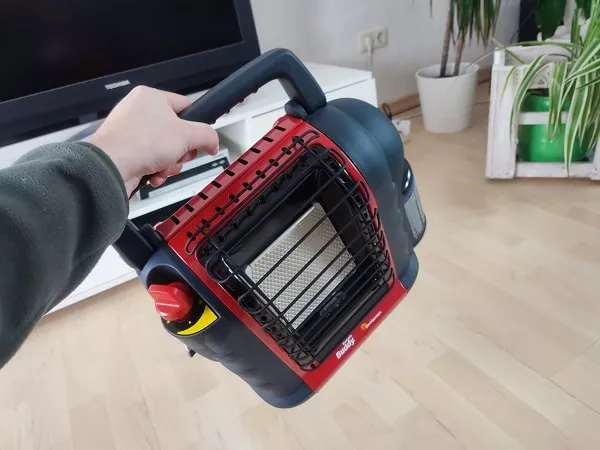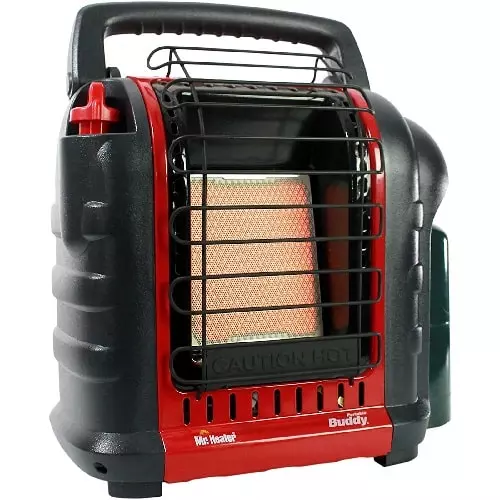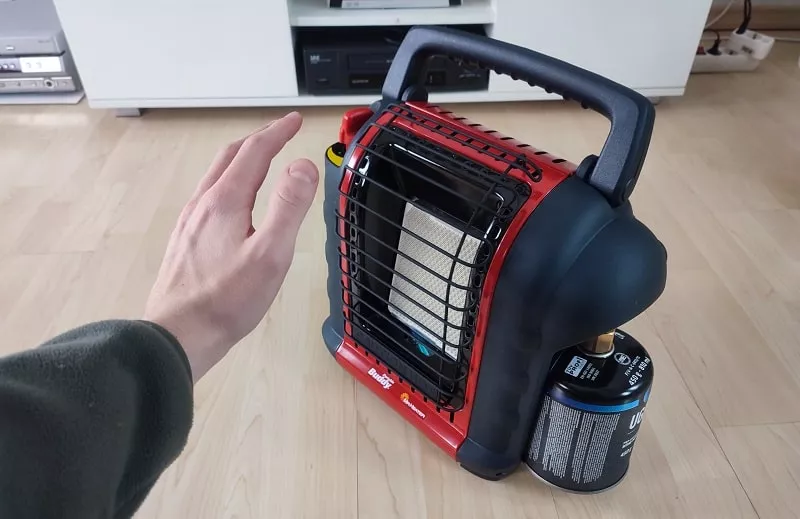Are propane heaters safe for indoor use? In this article, we’re going to answer this question by checking the temperature a propane heater produces. Then we can conclude, whether propane heaters cause a fire.
Then, we will follow up with a look at the combustion of propane gas and whether it creates any toxic waste materials.
After checking all of these “scary” aspects of propane heaters, you’re going to learn how to use a propane heater safely. And I am going to recommend you my favorite indoor-safe propane heater!
Quick answer: Yes, propane heaters are safe indoors! Propane heaters can emit enough heat to ignite household things (wood, curtains, carpets). So, it is important that you place your propane heater in a corner free of any obstructions blocking the heat. As long as your propane heater openly radiates into your living space, they are perfectly safe. If you have pets at home, you should rather use electric space heaters with hidden heating elements.
Summary: Safe and unsafe indoor propane heaters
There are different types of propane heaters. Here’s a quick summary of whether they are safe to use indoors:
| Heater type | Is this propane heater safe indoors? |
|---|---|
| Portable propane heater | safe |
| Ventless propane heater | safe |
| Vented propane heater | safe |
| Tank top heater | unsafe |
| Patio heater | unsafe |
| Torpedo heater | unsafe |
Portable propane heaters as well as ventless and vented propane heaters are usually designed for indoor use. They come with many safety features and don’t expose any flames.
Tank top heaters are not safe, because they usually don’t have any safety mechanisms. Patio heaters get way too hot for indoor spaces.
And torpedo heaters emit flames and produce temperatures high enough for industrial applications and construction sites.
How hot do propane heaters get?
Propane burns at a temperature of 5108°F ( 2,820°C). That’s the temperature of the blue flame itself.
The temperature decays with increasing distance. You can expect the temperature of a propane heater to be between 1,000°F and 2,000°F within the first 5 inches in front of the open heating area.
In comparison with a regular electric space heater, that’s very hot.
An electric space heater’s heating element is “only” 750°F. And an oil-filled radiator’s surface temperature is only around 180°F.
Can propane heaters ignite anything?
Yes, propane heaters can get hot enough to ignite things standing right in front of them.
The temperature right in front of a propane heater is between 1,000°F and 2,000°F.
That’s enough to ignite most plastic materials, as well as most fabrics of which carpets and curtains are made.
Also, temperatures between 1,000°F and 2,000°F can spontaneously ignite solid wood. The spontaneous ignition temperature of wood is around 1,100°F.
The exact temperature your propane heater emits depends, of course, on the heater model, the settings, and the design of the heating elements.
For example, propane heaters that have visible flames tend to produce higher temperatures than propane heaters that use an embedded propane flame to heat a metal grid, which in turn radiates the heat.
This does not change the heat output (measured in BTU per hour) of your propane heater. It just affects the heat distribution of your propane heater and thus the temperature immediately in front of it.
To conclude this section, you can assume the following:
All propane heaters emit temperatures that are hot enough to ignite most household items if you place them too close together.
Do propane heaters emit toxic gases?
Burning propane is a chemical reaction between the propane gas itself and the oxygen in your room.
Ideally, if your propane heater is adjusted properly and you have enough oxygen in your room, the combustion results in the formation of carbon dioxide and water vapor.
However, if the combustion is incomplete, propane burning can result in carbon monoxide and aldehyde production. Both aldehydes and carbon monoxide are toxic.
You always get this incomplete combustion when the balance of propane and oxygen is off. Ideally, it should be 1 part propane and 24 parts air.
So, what do you have to do to ensure that your propane heater burns properly and does not emit toxic gases?
The easiest thing is to regularly vent your room every few hours.
Even opening the window for just a minute already makes a big difference.
In general, I’d say that the risk of toxic gases when running a propane heater is very low, since there is always a way for air to enter your room.
Air enters your room through tiny gaps in the window and through the gaps below your closed door. Also, when you leave your room and open the door for a few seconds, this already exchanges air with neighboring rooms.
Are propane heaters safe around kids and pets?
So far we’ve seen that propane heaters can get very hot and that they can emit toxic gases (if you run them in rooms with little oxygen).
Another potential issue is kids and pets.
Kids and pets have all kinds of funny ideas. Also, they don’t act reasonably (at least I didn’t when I was a kid). So, running a propane heater around them is not a good idea.
Kids and pets can burn their fingers or their fur in front of running propane heaters.
And on top of that, they can start a fire if they tip over a propane heater without built-in tip-over protection.
Because of their exposed heating elements and the high temperatures, propane heaters are not safe around small children and pets.
 When I tip my propane heater, it immediately shuts off
When I tip my propane heater, it immediately shuts off
How to safely use a propane heater indoors
To safely run a propane heater indoors, you will have to minimize its fire and toxic gas risk.
Here’s how you can do that:
How to minimize toxic gas production
To minimize the production of aldehydes and carbon monoxide, you should regularly vent your room.
You can either do that by opening the window or by opening the door.
Venting refills your room’s oxygen levels, which ensures clean propane combustion.
Make the heater inaccessible to kids and pets
You can mount your propane heater at an elevated point to the wall, so it’s inaccessible to kids and pets.
Alternatively, you can build a pedestal to place your propane heater on, or you can at least run it from any other elevated position in your room.
That works for most pets and children, with the exception of cats. For cats, you will need a wall-mounted propane heater, or a safer space heater type such as an oil-filled radiator.
Leave the space in front of your propane heater open
The space right in front of your propane heater always has to be open! Never place any objects within 2-3 feet in front of your propane heater.
This eliminates the risk of fire.
Of course, you can quickly heat something up, or dry clothes for a few minutes. Or you can warm your hands on the propane heater.
As long as whatever you’re putting in front of your heater is only temporarily there and you constantly watch it, it’s okay.
But never place something in front of your heater and leave it unobserved.
Use a safe propane heater
There are different types of propane heaters. Some are really unsafe, such as torpedo heaters or tank top heaters, while others are specifically designed for indoor use.
Of course, you should stick to indoor propane heaters.
Indoor propane heaters come with all kinds of safety features. The Mr. Heater Big Buddy (click here to view it on amazon) has everything you need:
It’s portable. It can easily heat any room, even large living rooms with a high ceiling. It has different temperature settings.
And it has a built-in oxygen sensor, which shuts off the heating when there’s too little oxygen in your room. This makes the formation of toxic waste gases impossible.
That’s why I always recommend this propane heater. In my review, I included a list of how long a propane tank lasts with this heater.
Check it out here: Mr. Heater Big Buddy review (click to read it)

A realistic conclusion on propane heater safety
Wow, … I am a bit surprised myself after writing this article.
Analyzing the risks of propane heaters makes them appear so dangerous.
However, I have to emphasize one thing:
Propane heaters are completely safe indoors as long as you use them reasonably!
Yes, it might sound scary that they can get >1,000°F. But so what?
Just reduce your heater’s temperature setting if that’s too much for you.
Also, yes, the potential carbon monoxide emissions might also sound scary. But so what? Just vent your room every once in a while.
A tealight reaches the same temperature and also has a risk of carbon monoxide production. And you usually don’t consider tealights a threat.
There is a reason that propane heaters are such a popular backup heat source.
And in my honest opinion, you really have to challenge your luck to enforce a propane heater fire.
It’s very unlikely as modern propane heaters are very safe.
